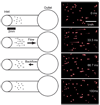An automated microdroplet passive pumping platform for high-speed and packeted microfluidic flow applications
- PMID: 20024045
- PMCID: PMC2882440
- DOI: 10.1039/b917147a
An automated microdroplet passive pumping platform for high-speed and packeted microfluidic flow applications
Abstract
Surface tension driven passive pumping is a microfluidic technology that uses the surface tension present in small droplets to generate flow. To enhance the potential of this type of passive pumping, a new 'micro passive pumping' technique has been developed that allows for high throughput fluidic delivery by combining passive pumping with a small droplet-based fluidic ejection system. Flow rates of up to four milliliters per minute (mL/min) were achieved that are solely limited by the channel geometry and droplet size. Fluid exchange rates can be performed within tens of milliseconds (ms) by delivering fluids from multiple nozzles. The technique can be extended to a multitude of platforms, as channels are not pressurized and therefore do not require bonding to a substrate. This technique provides a novel flow control for high-speed and packeted flow applications without requiring external tubing connections or substrate bonding.
Figures





Similar articles
-
Flow characterization and patch clamp dose responses using jet microfluidics in a tubeless microfluidic device.J Neurosci Methods. 2017 Nov 1;291:182-189. doi: 10.1016/j.jneumeth.2017.08.025. Epub 2017 Aug 23. J Neurosci Methods. 2017. PMID: 28842193 Free PMC article.
-
High speed droplet-based delivery system for passive pumping in microfluidic devices.J Vis Exp. 2009 Sep 2;(31):1329. doi: 10.3791/1329. J Vis Exp. 2009. PMID: 19727061 Free PMC article.
-
An inertia enhanced passive pumping mechanism for fluid flow in microfluidic devices.Lab Chip. 2012 Jun 21;12(12):2221-8. doi: 10.1039/c2lc20858j. Epub 2012 Mar 23. Lab Chip. 2012. PMID: 22441561
-
Droplet-based microfluidics for drug delivery applications.Int J Pharm. 2024 Sep 30;663:124551. doi: 10.1016/j.ijpharm.2024.124551. Epub 2024 Aug 4. Int J Pharm. 2024. PMID: 39106935 Review.
-
Logic digital fluidic in miniaturized functional devices: Perspective to the next generation of microfluidic lab-on-chips.Electrophoresis. 2017 Apr;38(7):953-976. doi: 10.1002/elps.201600429. Epub 2017 Feb 21. Electrophoresis. 2017. PMID: 28059451 Review.
Cited by
-
Advances in passively driven microfluidics and lab-on-chip devices: a comprehensive literature review and patent analysis.RSC Adv. 2020 Mar 23;10(20):11652-11680. doi: 10.1039/d0ra00263a. eCollection 2020 Mar 19. RSC Adv. 2020. PMID: 35496619 Free PMC article. Review.
-
Novel, Emerging Chip Models of the Blood-Brain Barrier and Future Directions.Methods Mol Biol. 2022;2492:193-224. doi: 10.1007/978-1-0716-2289-6_11. Methods Mol Biol. 2022. PMID: 35733046
-
Influence of surface tension-driven network parameters on backflow strength.RSC Adv. 2019 Apr 2;9(18):10345-10351. doi: 10.1039/c8ra09756a. eCollection 2019 Mar 28. RSC Adv. 2019. PMID: 35520946 Free PMC article.
-
Flow characterization and patch clamp dose responses using jet microfluidics in a tubeless microfluidic device.J Neurosci Methods. 2017 Nov 1;291:182-189. doi: 10.1016/j.jneumeth.2017.08.025. Epub 2017 Aug 23. J Neurosci Methods. 2017. PMID: 28842193 Free PMC article.
-
Biomimetic approaches to control soluble concentration gradients in biomaterials.Macromol Biosci. 2011 Apr 8;11(4):483-92. doi: 10.1002/mabi.201000448. Epub 2011 Jan 24. Macromol Biosci. 2011. PMID: 21265021 Free PMC article. Review.
References
-
- Walker GM, Beebe DJ. A passive pumping method for microfluidic devices. Lab Chip. 2002;2:131–134. - PubMed
-
- Berthier E, Beebe DJ. Flow rate analysis of a surface tension driven passive micropump. Lab Chip. 2007;7:1475–1478. - PubMed
-
- Meyvantsson I, Warrick JW, Hayes S, Skoin A, Beebe DJ. Automated cell culture in high density tubeless microfluidic device arrays. Lab Chip. 2008;8:717–724. - PubMed
-
- McDonald JC, Whitesides GM. Poly(dimethylsiloxane) as a Material for Fabricating Microfluidic Devices. Acc. Chem. Res. 2002;35:491–499. - PubMed
-
- Ju J, Park JY, Kim KC, Kim H, Berthier E, Beebe DJ, Lee SH. Backward flow in a surface tension driven micropump. J. Micromech. Microeng. 2008:18.
MeSH terms
Substances
Grants and funding
LinkOut - more resources
Full Text Sources

